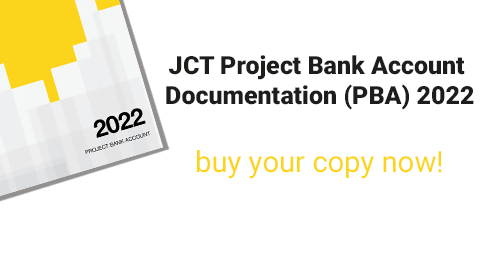Blog Author: John Riches – Vice-Chair, JCT Drafting Sub-Committee
Project bank account provisions are now available for all JCT contract suites – improving cash flow through the industry…
Lord Denning said in Modern Engineering (Bristol) Ltd vs Gilbert Ash (Northern) Ltd 1973 that “cash flow is the lifeblood” of the construction industry – a sentiment that is particularly apposite where parties feel they are not being paid enough or on time. There have been a plethora of reports on the ills of the industry featuring cash flow related problems.
“What is needed [to improve cash flow] is an agreed procedure to ensure that payments are made regularly and promptly,” said the Banwell Committee in 1964. Fast forward to the two Latham reports, which retrod the familiar ground of cash flow. At last, we got an outcome in terms of adjudications and payment provisions in the 1996 Construction Act, subsequently amended in 2009. Throw in a non-construction piece of legislation, the Late Payment of Commercial Debts (Interest) Act 1998, setting a penal rate of interest, and we have all the ingredients to ensure prompt payment – cash flow at last.
Despite the courts having revealed weaknesses in the drafting of the 2009 legislation, and how applying the payment rules has accordingly become more difficult, payment has improved overall as a result of Latham.
Dissatisfaction remains, however. The government applied more pressure in 2015 and 2017 by introducing a duty to report payment practices and performance – a name and shame type revelation. Did this shame the industry into prompt payment practices? Central government performance on payment is gauged on two payment periods, one of 30 days and one of five days. Data from Build UK (for which I am grateful) shows that in July 2018 no main contractors were paying within 30 days, but in February 2022 half of main contractors were doing so. Things have improved. But there are many SMEs within the industry who think this is not good enough.
The public sector is putting more pressure on. In 2016 Scotland introduced project bank accounts (PBAs) for projects over £2m from March 2019. Since 2009, UK central government departments, their agencies and non-departmental public bodies have been told to move to a position where PBAs are adopted unless there are compelling reasons not to do so.
The Construction Playbook on public works projects (also impacting on the private sector) says: “The government understands the importance of prompt, fair and effective payment in all businesses.” Being paid promptly for work carried out in accordance with the contract ensures businesses have a healthy cash flow throughout the supply chain, especially at the lower tiers.
The construction sector is ripe for introduction of PBAs as the next contributor to improving payment practices and cash flow. A PBA is a bank account dedicated to the project. The account is ring fenced and members who sign up to the PBA, the main contractor and subcontractors, are all paid directly and simultaneously from the PBA. There is no time lag for the supply chain: they get their money on the same date as the main contractor. No 60-day payment terms: whatever the standard contract payment period is, it applies to everyone who has signed up to the PBA.
The JCT has this year updated (not so much an update but supercharging) the old 2016 PBA documentation (available from the JCT website). Great effort has been made to provide a working document that will slot into the pressures being applied on the industry to adopt PBAs. In drafting this document, the prime objective was to use the existing (and future) standard form contracts. If you want a PBA there is the bolt-on to whatever contract suite you are using. It has been designed around the most-used suites.
All of the familiar valuation processes remain in the primary contract documents. These are dealt with arriving at the sum out of the PBA. All of the ordinary payment notices, pay less notices and the like operate as normal.
For everybody to be paid out of the PBA a payment schedule is sent to the employer identifying the sums to be paid to the main contractor and each subcontractor. They are all paid electronically at once. Good for cash flow.
But what about the great desire to be paid the right amount of money at the right time? The PBA very directly addresses this. Because the PBA is a system of dealing with the payment itself, establishing the right amount remains within the primary contract. There is less scope for argument on when the money is going to turn up, and the amount is known very quickly because of the way the PBA operates. Any shortfall that does not take the payee up to the right amount is readily identified. In terms of behavioural change, it is hoped an effectively operated PBA will leave the parties free to focus on resolving any differences affecting the right amount. Even domestic amounts between main contractor and subcontractor will be paid through the PBA once the amount is established.
What about final accounts and retention? The JCT PBA 2022 works right through to closure of the entire project. Will the JCT PBA 2022 rejuvenate the lifeblood?

